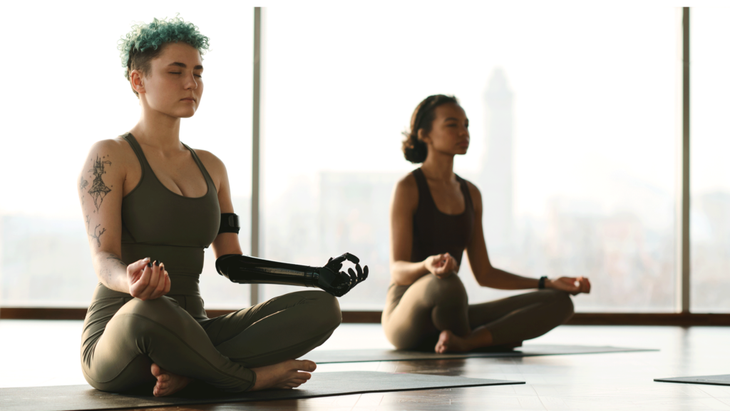No products in the cart.
Outdoor Adventure
Colleges Are Relying on Yoga to Help Stressed Students
On college campuses across the country, students are taking care of their mental health with movement. But not just with the “Cozy Cardio” or “Silent Walking” workouts trending on TikTok. Instead, they’re turning to a practice that we’ve known about for ages: yoga.
At the University of Michigan, Ann Arbor, dozens of students take yoga classes at aUM Yoga, a studio located on campus. Studio owner and certified yoga teacher Jessie Bryce Lipkowitz says some students have told her that the practice has eased their depression and anxiety, while others say it’s been a way to manage stress or improve their body image.
At Widener University in Chester, Pennsylvania, the athletics department provides a weekly yoga class for student athletes. They learn breathing exercises, which helps them regulate their response to tough emotions, says Larissa Gillespie, the associate director of athletics. She says that the yoga class also aims to help them manage the pressures that come with being high-performance athletes.
“Wellness is trending,” says Marcelle Hayashida, associate vice chancellor for wellness, health, and counseling services at the University of California, Irvine, where students can take yoga classes at the gym located on campus.
The need is there. Between 2013 and 2021, the percentage of college students with mental health concerns skyrocketed by nearly 50 percent. In addition, a 2020 nationwide survey, which included 33,000 undergraduates found that nearly 40 percent felt depressed, while more than 30 percent were anxious. Loneliness was also a top concern. Even before then, a 2016 survey revealed that many students reported issues with roommates, relationships problems, and academic stress.
Unfortunately, many college counseling centers don’t have enough therapists to meet the rising demand, says Lienna Wilson, a psychologist in Princeton. New Jersey. Wilson, who counsels college students in her private practice, says that students sometimes have to wait more than a month for an appointment in a college counseling center, and depending on insurance coverage, cost can be an issue.
There’s no clear-cut solution to this ongoing problem, but many colleges and universities are offering wellness classes like yoga to promote self-care.
Colleges See Yoga As a Powerful Wellness Tool
Yoga draws on the tradition of physical movement, breathwork, and mindfulness and has been backed by science time and again for its influence on reducing emotional and physical tension.
A 2020 study published in Frontiers in Psychiatry found that students who participated in a wellness program including yoga, meditation, and positive psychology training felt better equipped to handle stress and reported fewer symptoms of depression. Yoga has also been credited with reducing academic stress in students and improving sleep.
aUM’s Lipkowtiz can relate. Not long after college, she hit a rough patch. “I was in a toxic relationship, and I was drinking too much,” she admits. It was the “lowest point” in her life, says Lipkowitz, who was 22 years old at the time.
Like many other young adults, Lipkowitz found solace through yoga. “Moving my body made me happier,” she recalls. Attending classes also helped her connect with others, which eased her loneliness. Experiences like these can be invaluable, especially since the mental health crisis has made therapy harder to access.

Her experience inspired Lipkowitz to start aUM Yoga, where she strives to provide a community for students. Along with offering yoga classes, the teachers emphasize general wellness and creating a safe space for everyone, says Lipkowitz.
Since aUM yoga isn’t affiliated with the University of Michigan, classes aren’t free. However, Lipkowitz includes outreach to the student population by offering a select number of scholarships each year.
At many other colleges, the cost of on-campus yoga is included with the fees students pay each semester to use facilities on campus.
Maximizing the Effects of Yoga for Stress-Management
Certified yoga therapist Pamela Crane is accustomed to teaching populations who rely on yoga as one component of a larger wellness program. Crane teaches yoga at an intensive outpatient program at Bahia Health in Chula Vista, California and explains that focusing on your breath during yoga and making sure your exhalation is longer than your inhalation can activate the parasympathetic nervous system. This, in turn, eases symptoms of anxiety, which can include an upset stomach, sweating, and a racing heart.
Depression, on the other hand, can make you feel lethargic and numb. Crane says that sequences of poses, such as Sun Salutations (Surya Namaskar A), can get your blood flowing and heart pumping and reconnect you to sensations in your body.
It’s not just the physical exercise that bring benefits. The ancient practice is anchored in ethical principles, known as the yamas and niyamas, which are essentially rules for living. When these are explained in a yoga class, they can become a guide for students outside of class as well.
For example, Crane says that the principle of ahimsa means caring for yourself, as well as for others. Extending kindness toward yourself, or having self-compassion, is one way to practice ahimsa. This can be a powerful antidote to rumination and catastrophizing, which are common symptoms of anxiety, according to Crane.
Yoga also provides an opportunity for self-study, called svadhyaya. “It invites you to examine what’s going on in your life and how it impacts the way you move through the world,” Crane explains. Like self-reflection, this practice can spark insight. When used in conjunction with talk therapy, it can be a powerful tool.
This same approach has been relied on for years among incarcerated populations, such as what is provided by Prison Yoga Project. Research indicates yoga can bring relief from anxiety and depression and contribute to changed behavior, including enhanced self-compassion and lessened impulsivity.
Distinguishing Yoga From Therapy
Despite its proven benefits, yoga shouldn’t be mistaken for a cure-all. Wilson cautions that with the rise of wellness culture, almost anything can seem therapeutic. On social media, for instance, influencers tout the merits of ice baths for depression and lettuce water for insomnia. When it comes to any “remedy,” including yoga, it’s also important to understand the limitations.
This is especially the case with depression, generalized anxiety, eating disorders, and other serious afflictions. In these instances, yoga should never be relied upon as the answer. Mental illness can’t be fixed with movement alone. “Yoga can be part of a wellness program, but it’s not a replacement for therapy,” Hayashida says. Instead, yoga is a complementary practice.
Most yoga classes are taught by certified yoga teachers which differ from certified yoga therapists, such as Crane, who complete “yoga therapy training” designed to teach instructors how to help students with specific needs. Even then, the teachers who complete this training are not licensed psychotherapists.
There are also “trauma-sensitive” or “trauma-informed” yoga classes that are meant to help survivors of sexual violence and other traumatic experiences regain a sense of safety in their bodies, Hayashida says. Unlike a regular yoga class, trauma-focused yoga should be led by teachers who are trained in the subtle ways that post-traumatic stress disorder can present. These classes are designed to support survivors in ways both overt and less obvious. Teachers emphasize breathing as well as establishing safe boundaries with others and can foster a sense of community.
While there’s no denying that yoga can feel therapeutic, feeling better isn’t the same as recovery, especially in students who struggle with addiction, eating disorders, and trauma. This is where talking with a therapist comes in. Cognitive-behavioral therapy (CBT) helps individuals examine their feelings and question unhelpful thoughts. Research shows that cognitive-behavioral therapy (CBT) with a psychotherapist who has years of training and experience can reduce the symptoms of anxiety, depression, and post-traumatic stress disorder (PTSD). “It’s evidence-based care that helps you heal,” Hayashida says.
Bottom Line
If you or a college student you know are feeling sad, anxious, stressed to the point of overwhelm, or just not yourself, yoga might be able to help, but not in place of therapy. Yoga can, however, function as a complement to therapy or it may be able to moderate symptoms until you can access other forms of support.
Despite all its benefits, practicing yoga is like taking vitamins or any wellness routine—it can be beneficial for your mind and body when taken on a regular basis, but sometimes it’s not enough.
Correction: An earlier version of this article incorrectly stated that yoga classes are provided to students at UC Irvine free of charge.
About Our Contributor
Juli Fraga is a psychologist and freelance health writer who specializes in service journalism and human interest stories about women’s health topics. She also converts scientific findings from the latest mental health research into meaningful information for the everyday person. She has written for The New York Times, NPR, The Washington Post, Self, WIRED, and Real Simple.
Source link

